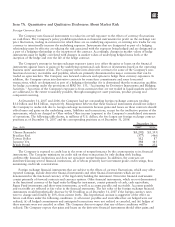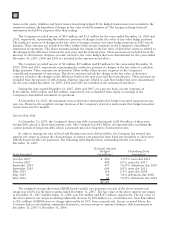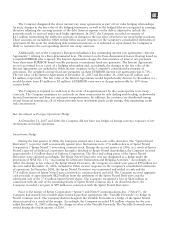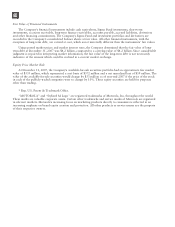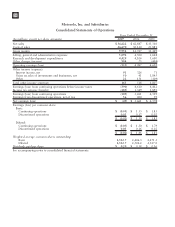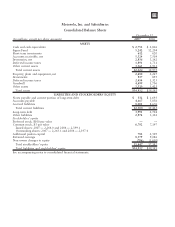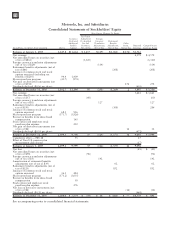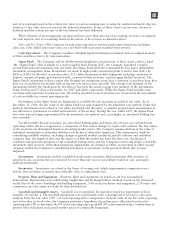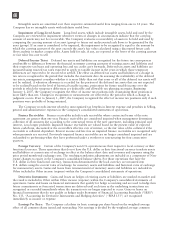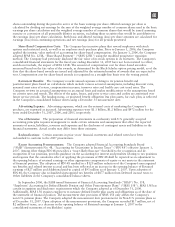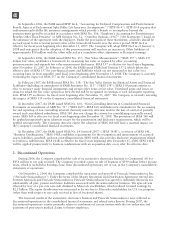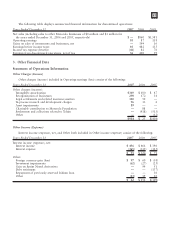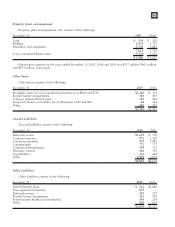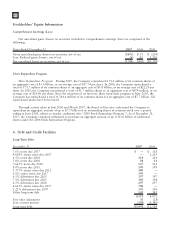Motorola 2007 Annual Report Download - page 89
Download and view the complete annual report
Please find page 89 of the 2007 Motorola annual report below. You can navigate through the pages in the report by either clicking on the pages listed below, or by using the keyword search tool below to find specific information within the annual report.
unit of accounting based on the relative fair value of each accounting unit or using the residual method if objective
evidence of fair value does not exist for the delivered element(s). If any of these criteria are not met, revenue is
deferred until the criteria are met or the last element has been delivered.
When elements of an arrangement are separated into more than one unit of accounting, revenue is recognized
for each separate unit of accounting based on the nature of the revenue as described above.
Sales and Use Taxes—The Company records taxes imposed on revenue-producing transactions, including
sales, use, value added and excise taxes, on a net basis with such taxes excluded from revenue.
Cash Equivalents: The Company considers all highly-liquid investments purchased with an original maturity
of three months or less to be cash equivalents.
Sigma Fund: The Company and its wholly-owned subsidiaries invested most of their excess cash in a fund
(the “Sigma Fund”) that is similar to a money market fund. During 2007, the Company liquidated a similar
second fund and now maintains only one fund. The Sigma Fund portfolio is managed by four major independent
investment management firms. Investments are made in high-quality, investment grade (rated at least A/A-1 by
S&P or A2/P-1 by Moody’s at purchase date), U.S. dollar-denominated debt obligations including certificates of
deposit, commercial paper, government bonds, corporate bonds and asset- and mortgage-backed securities. The
Sigma Fund’s investment policies require that floating rate instruments must have a maturity, at purchase date, that
does not exceed thirty-six months with an interest rate reset at least annually. The average reset maturity of the
investments held by the funds must be 120 days or less with the actual average reset maturity of the investments
being 40 days and 53 days at December 31, 2007 and 2006, respectively. While the Sigma Fund includes some
securities with maturities beyond one year, the fund is classified as short-term because it represents the investments
of cash available for current operating needs.
Investments in the Sigma Fund are designated as available-for-sale securities recorded at fair value. As of
December 31, 2006, the fair value of the Sigma Fund was approximated by the amortized cost method. Under this
method, investments were valued at cost when purchased and thereafter, a constant proportionate amortization of
any discount or premium is recorded until maturity of the security. During the year ended 2007, the Sigma Fund
fair value was no longer approximated by the amortized cost method and, accordingly, an unrealized holding loss
was recorded.
For all available-for-sale securities, any unrealized holding gains and losses, net of taxes, are excluded from
operating results and are recognized as a component of Non-owner changes to equity until realized. The fair values
of the securities are determined based on prevailing market prices. The Company assesses declines in the value of
individual investments to determine whether such decline is other-than-temporary. This assessment is made by
considering available evidence, including changes in general market conditions, specific industry and individual
company data, the length of time and the extent to which the market has been less than cost, the financial
condition and near-term prospects of the individual issuing entity, and the Company’s intent and ability to hold the
investment until recovery. Other-than-temporary impairments are charged to Other, as presented in Other income
(expense) within the Company’s consolidated statements of operations, in the period in which they become
impaired.
Investments: Investments include available-for-sale equity securities, held-to-maturity debt securities at
amortized cost, securities that are restricted for more than one year or not publicly traded at cost, and equity
method investments.
Inventories: Inventories are valued at the lower of average cost (which approximates computation on a
first-in, first-out basis) or market (net realizable value or replacement cost).
Property, Plant and Equipment: Property, plant and equipment are stated at cost less accumulated
depreciation. Depreciation is recorded using straight-line and declining-balance methods, based on the estimated
useful lives of the assets (buildings and building equipment, 5-40 years; machinery and equipment, 2-10 years) and
commences once the assets are ready for their intended use.
Goodwill and Intangible Assets: Goodwill is not amortized, but instead is tested for impairment at least
annually on October 1. The goodwill impairment test is performed at the reporting unit level and is a two-step
analysis. First, the fair value (“FV”) of each reporting unit is compared to its book value. If the FV of the reporting
unit is less than its book value, the Company performs a hypothetical purchase price allocation based on the
reporting unit’s FV to determine the FV of the reporting unit’s goodwill. FV is determined using a combination of
present value techniques and quoted market prices of comparable businesses.
81


